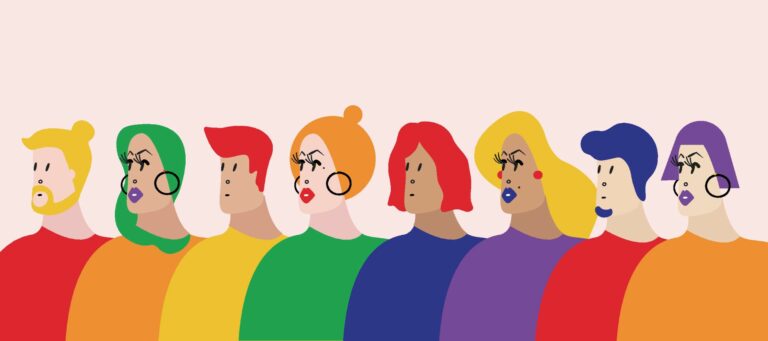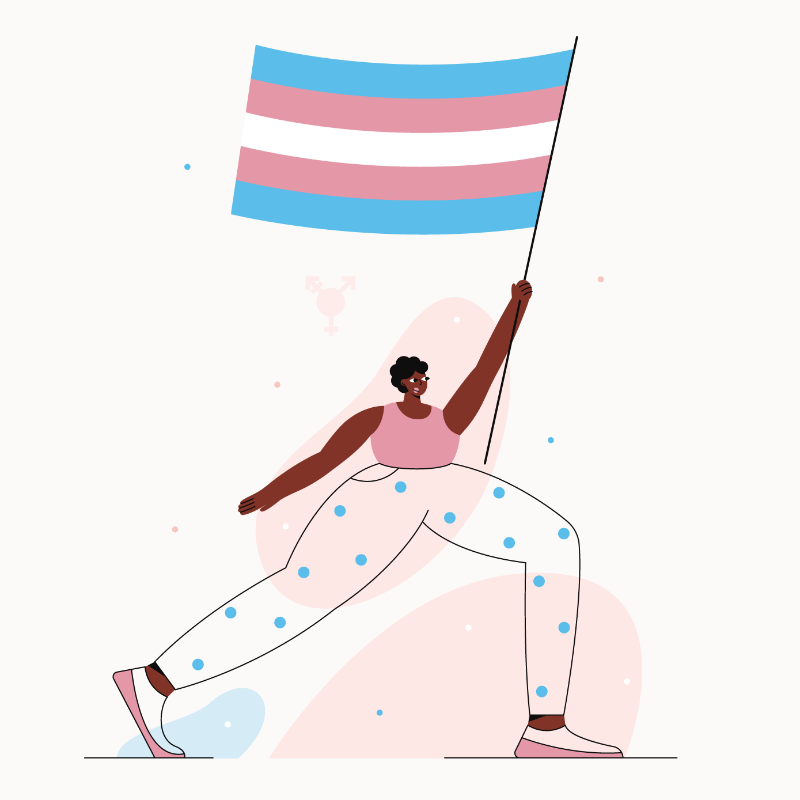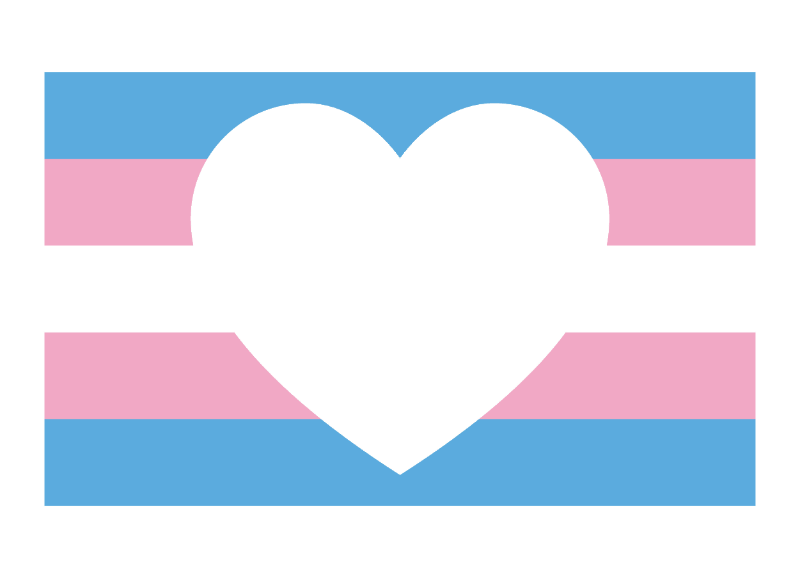Becoming trans – starting your journey to a real you

The journey that many people take toward becoming trans involves recognizing their own gender identity as something other than the one assigned to them at birth. The road that trans people take toward accepting, transitioning, and becoming who they feel themselves to be can be a hard one.
From taking those first cautionary steps into performing the identity that you feel yourself to be, coming out to family and friends, and making efforts to build a relationship with other trans women, men, or CIS persons, support and information are vital to your success.
In this article, we’ll cover some basic information on what you need to know for becoming trans, including what terms to avoid, what it means to you, and the process that is involved for many. We’ll also include helpful resources and information.

Table of contents [ Show Hide ]
- What is a ‘shemale’ and why you should never use that word
- What does becoming trans mean in the context of transgenders?
- MTF/FTM transition: becoming trans explained
- How long does becoming trans take?
- Resources for transgender people
- Issues and advice for someone becoming trans
- Our recommendation for transgender dating sites and apps
- Becoming trans FAQ
What is a ‘shemale’ and why you should never use that word
A “Shemale” is a term that became popularized by the porn industry and is a slur in sex work to refer to transgender porn, usually depicting male to female trans persons. Shemale porn, as it was and is known, is one of many slurs, including tgirl, tranny, ladyboy, and more.
The term is a pejorative phrase that refers to a male “she”, and is used within the context of referring to a transsexual person as a sexual object. This is most often to sate a fetish or kink that isn’t interested in the trans person as a person.
Referring to a trans person as a “shemale” ignores their human identity, personhood, and rights. It debases their journey and struggles to be recognized. Being referred to in that way makes it that much more difficult for them to make real relationships.
If you are looking for appropriate terms to use, “trans” is acceptable. However, what you really need to do is talk to the person and ask them what their name is. It’s a much better approach than looking for a label.
What does becoming trans mean in the context of transgenders?
To transition is when you are in the process of changing your identity, specifically your gender identity, from the one that you were assigned to at birth. This can mean being assigned a male identity because of male genitalia, but identifying later on as a woman and working to make that a reality.
In a nutshell, it is a process of becoming who you feel that you want to be.
There’s no hard line to say that someone is in the process of transitioning or for how far they need to go before they are finished. The journey of transitioning is a deeply personal one that requires you to find a point in your own search that makes you happy.
This could be wearing clothes normally worn by the other gender. It can also mean working toward the goal of surgically altering one’s appearance and genitalia to match what they feel like.
Once you make the decision personally that you are of another gender and you wish to embrace that, you have already begun to transition. Depending on the goal you set for becoming trans, this can take either no time at all or be a lifelong endeavor.
MTF/FTM transition: becoming trans explained
The process of becoming trans starts similarly: you need to take time to assess your own feelings and self first. Do you want to identify as a woman or a man? Are you prepared for the long process of transitioning?
Once you come to a conclusion, and in this case decide to transition, the length of time it will take to become trans will depend on what your goal is. If you are satisfied with dressing differently or wearing make-up, it can be done quickly.
Some people who choose to transition do so with the idea of becoming as much a woman as possible, which involves taking HRT, or hormone replacement therapy. Hormone therapy is done to alter one’s level of estrogen and can help MTF trans people look more feminine. For FTM, testosterone is used.
According to the MayoClinic, “the maximum effect will occur within one to two years [of taking HRT].” Users will notice “decreased facial and body hair growth. This will begin six to 12 months after treatment. The maximum effect will occur within three years.”
Your use of HRT or testosterone depends on what a physician or consultant suggests, and can vary on a case-by-case basis.
Becoming trans can also involve taking the process further with gender reassignment surgery. This includes a regiment of HRT and surgical procedures such as plastic surgery for facial feminization and breast augmentation, as well as surgery for changing your genitals.
Depending on how you are personally approaching the idea of becoming trans, you’ll also need to consider post-surgery maintenance and care, which can take years or even the rest of your life.

How long does becoming trans take?
Finding and reaching the milestone of your true gender is a personal, individual struggle and journey filled with ups and downs. Reaching the point to where you are happy depends entirely on what your goal is for becoming trans.
If you are just looking to pass off your appearance as the other sex, then it can take as little as a few months, if that. If you want to go through with sex reassignment surgery, that can take years of hormone therapy, planning, and adjustment before receiving the surgery.
Becoming trans can be a struggle with the maintenance of appearance and identity of their chosen gender. For example, trans women who opt for surgery will need regular dilation of their new sex organs to prevent closure.
There is also the adjustment to intimacy as someone with new sex organs. This will take time to get used to, and may require practice and consultation with a physician before you can reliably and safely enjoy it.
The road to becoming trans and the person you want to be is varied and will depend on where you want to go.
Resources for transgender people
Whether you need support, advice, interventions, or basic information, it’s important to keep yourself informed and learn as much about the process of transitioning as you can. This is especially important for those with gender dysphoria looking to understand their situation.
To help you with finding the necessary information you may need, we would like to direct you to GLAAD which has many helpful resources for becoming trans or facing issues as a trans person. In addition, here are just some of the links you can find there:
For transgender people in crisis
- The Trevor Project is a 24/7/365 Lifeline. You can also call them at 866-4-U-TREVOR (866-488-7386) or use their TrevorChat, an online instant messaging option. They also have text-based support at TrevorText. For peer-to-peer support, you can go to TrevorSpace from anywhere in the world.
- The National Suicide Prevention Lifeline at 800-273-TALK (8255)
- Trans Lifeline at 877-565-8860
Transgender organizations
- National Center for Transgender Equality (NCTE) (advocacy)
- Transgender Law Center (TLC) (legal services and advocacy)
- Gender Spectrum (support for families, trans youth, and educators)
Transgender programs
- GLAAD’s Transgender Media Program (media advocacy)
- Freedom for All Americans (policy and legislative advocacy)
- PFLAG Our Trans Loved Ones (support for families of people who are trans)
Issues and advice for someone becoming trans
There are some common issues facing transgender people who are becoming trans or have been on their journey. These can range from access to resources or being targeted with malicious intent as a trans person. To provide insight, we’ve broken these down into more general topics:
- Health – Trans people face a larger number of health disparities than CIS persons. This can include limited access to medical facilities which specialize in trans persons, a lack of medically necessary transition-related pre- and post-op healthcare, higher rates of HIV infection, and ighh rates of suicide.
- Economics – Discriminatory hiring or housing practices can place trans people as victims to high rates of poverty and unemployment, as well as discrimination in access to education. At worst, trans people may end up as homeless. A trans person is 2x as likely to be living in extreme poverty.
- Safety – Violence against trans people has become such a risk that the American Medical Association called it an epidemic in 2019. There is an increased chance of being targeted as a victim of violence for trans people than as a CIS person. Discrimination and prejudice remain a constant challenge.
- Civil Rights – Trans people continue to fight for their recognition and civil liberties as their legal needs cover a wide range of topics in their day-to-day life.
- Companionship and romance – Finding partners who accept you for who you are can be a challenge. People with a transamory fetish can make this experience difficult as well. Trying to find a reliable partner on top of other issues can make romance all the more exhausting.

Our recommendation for transgender dating sites and apps
Here are our latest recommendations and top picks for the best transgender dating sites and apps:
- Large database of verified & attractive Asian and European singles
- Efficient communication and instant messaging
- Top-level safety and professional support
- Safe, secure casual arrangements with transgender singles, couples, and more
- Engage with an active online community that is experienced
- Search by city for local matches or plan trips
- Meet real asian, european, and latino singles
- Real-time communication with efficient tools
- Professional dating services
- Find you special someone
- Active & open community
- Plenty of success stories
- 24 hrs customer service
- One on one Romance Consultations.
- 100% real users.
Becoming trans FAQ
Transitioning is a personal journey that can be made easier by informing yourself of the potentially difficult moments to come. It’s difficult to provide a complete resource guide for all the problems you can run into, as everyone’s situation is unique to them.
Nevertheless, we have answered some of the most frequently asked questions about becoming trans to help you get started with your own transitioning.
What are the requirements for becoming trans?
There’s no hard requirement for being transgender other than a willingness and interest to identify as someone who is trans, whether it be a woman, man, or genderfluid. The only requirement is that you want to be transgender.
How much does becoming trans cost?
This entirely depends on how far you want to take your transitioning. For someone who is simply looking for a superficial change, like make-up and clothing, this will only cost you as much as what you’d like to spend.
However, for MTF trans persons, a full surgery and further care can cost upward of $50,000, and for FTM even $75,000. Costs do vary, but if you want to take it as far as is currently possible it will be expensive.
At what age does being transgender start?
There is no hard age for becoming trans. More and more young people are coming forward with the belief that they are of another gender, so this truly means that it can start at any age.
With that said, there are recommendations for when someone should begin taking something like HRT or gender reassignment surgery, as especially younger people may not be prepared or certain of their identification.
How can I be transgender without surgery?
A state of mind is really the most important asset for being transgender. If you feel like you are trans, then that should be enough for you already to start. How much further you take it depends on what you want.
Wearing make-up, changing your clothing styles, changing your diet and exercise, and going so far as to take hormone therapy are all ways to explore your transgender identity without surgery.




